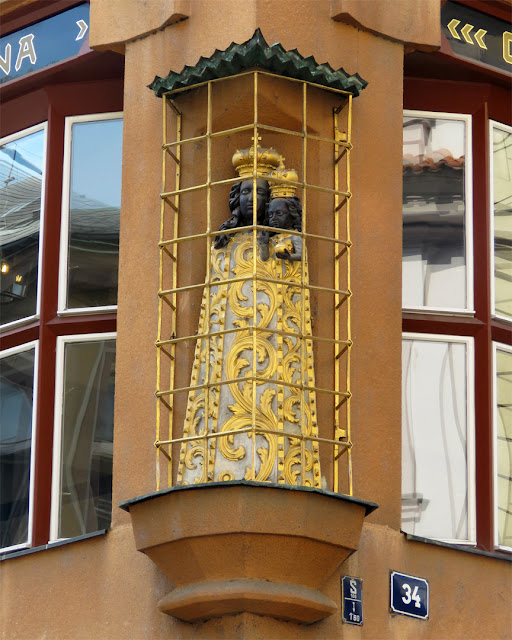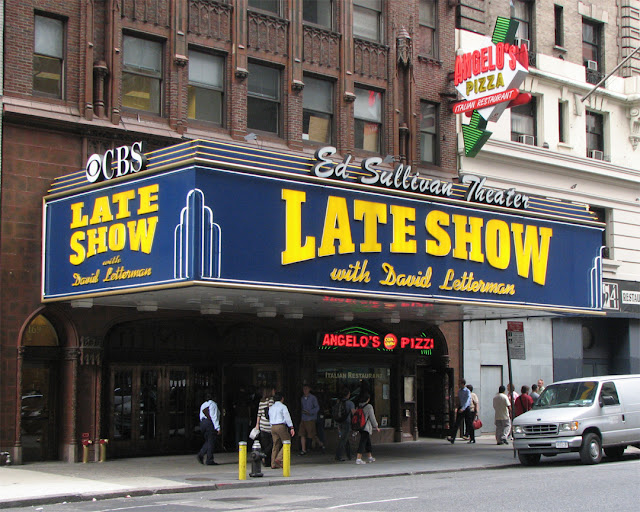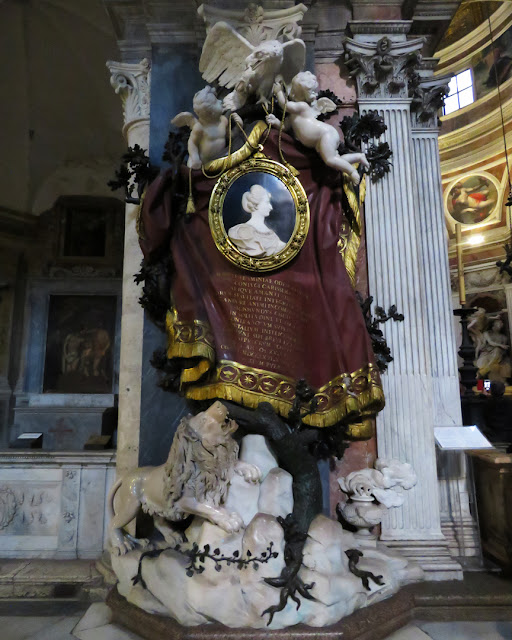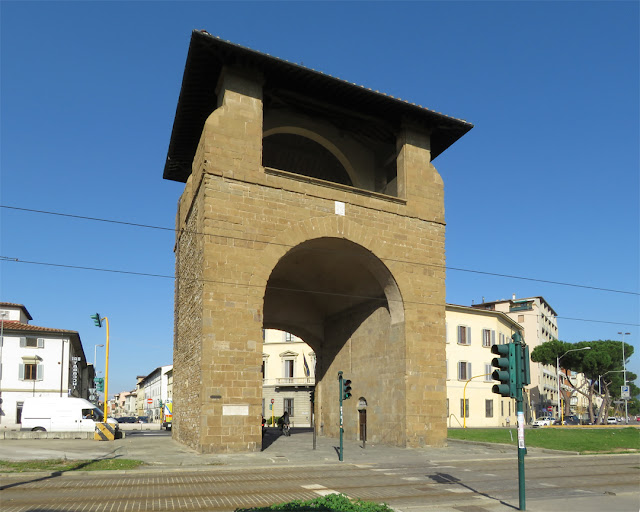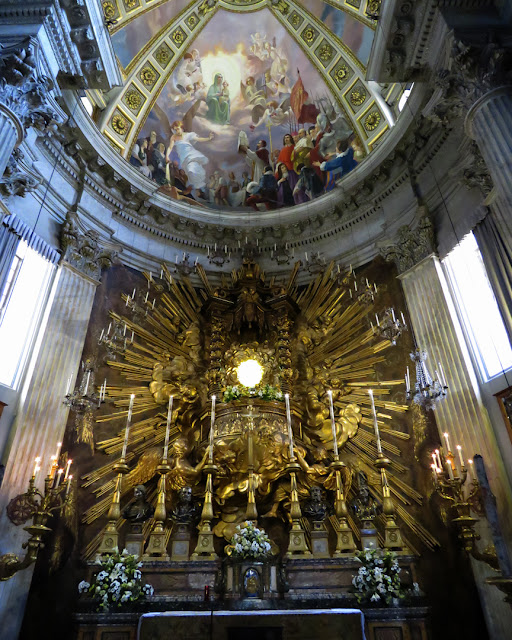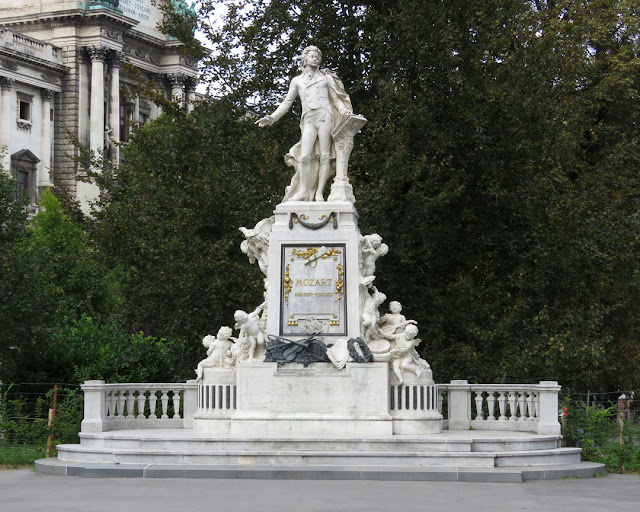Saturday, August 31, 2019
Habakkuk and the Angel
‘Habakkuk and the Angel’ by Gian Lorenzo Bernini, 1655-57
Cappella Chigi (Chigi Chapel)
Santa Maria del Popolo
Piazza del Popolo
Rome, May 2019
“A surviving drawing from the workshop of Bernini proves that the architect at first planned to move the two Raphaelesque statues to the empty niches by the altar but soon he changed his mind. He created two new statues depicting the Prophet Daniel and Habakkuk, and these sculptures formed a larger composition facing each other diagonally across the space of the chapel. Bernini created a spatial relationship that enlivened the entire chapel, turning its classical form to a new religious use. The statue of Habakkuk was placed in the niche to right of the main altar. The sculpture was set up in its place in November 1661 but Bernini was working on it since October 1656. A terracotta model for the statue also survived in the Vatican Museums. Since being cleaned in the 1980s it has been attributed to Bernini himself but Dickerson and Sigel thought to be the work of an assistant, probably Ercole Ferrata who was working with Bernini around the time of the creation of the Habakkuk.” (Habakkuk and the Angel, Wikipedia)
Friday, August 30, 2019
Thursday, August 29, 2019
James Gordon Bennett Memorial
James Gordon Bennett Memorial by Antonin Carlès, 1894
Herald Square
6th Avenue and 34th Street
New York, September 2007
Wednesday, August 28, 2019
Tuesday, August 27, 2019
Isidore Taylor
Grave of Isidore Justin Séverin Taylor (1789-1879)
Cimetière du Père-Lachaise, (Père Lachaise Cemetery)
Quartier du Père-Lachaise, 20th arrondissement
Paris, July 2014
“Isidore Justin Séverin Taylor was born in Brussels on 5 August 1789 and died in Paris on 6 September 1879. He was closely associated with the development of French theatre, a noted traveller and author, and a philanthropist.” (Baron Isidore Justin Séverin Taylor, Wikipedia)
Monday, August 26, 2019
House of the Black Madonna
House of the Black Madonna, by Josef Gočár
Celetná / Ovocný trh
Prague, September 2017
“The House of the Black Madonna is a cubist building in the ‘Old Town’ area of Prague, Czech Republic. It was designed by Josef Gočár. It is currently in use as the Czech Museum of Cubism and includes the Grand Café Orient restaurant on the first floor. The House of the Black Mother (U Černé Matky Boží), sometimes referred to as Black Mother of the Lord, was designed and built between 1911 and 1912 on the corner of Celetná Street and Ovocný trh. Josef Gočár built the house as the first example of cubist architecture in Prague, and it remains probably the most celebrated. Even without historical details of the baroque building surrounding it, the House of the Black Madonna maintains the atmosphere of the neighborhood. The house was given its name by the stone sculpture that originally adorned one of the two Baroque buildings on the same lot. After many years altered use in the interwar period and under communist rule, the house was closed in January 2002 and re-opened after extensive restoration in November 2003.” (House of the Black Madonna, Wikipedia)
Sunday, August 25, 2019
Daniel and the Lion
‘Daniel and the Lion’ by Gian Lorenzo Bernini, 1655-57
Cappella Chigi (Chigi Chapel)
Santa Maria del Popolo
Piazza del Popolo
Rome, May 2019
“The statue of Daniel was placed in the niche to left of the entrance. On 26 June 1657 Bernini received 1000 scudi for the figure of Daniel which was then already in its place. The surviving preparatory drawings (four studies in the Museum der bildenden Künste in Leipzig) prove that the inspiration for the statue was provided by the famous Laocoön group. The drawings show the creative process through which the classical models were studied and reinvented by the Baroque artist. A preparatory terracotta model for the statue also survived in the Vatican Museums. Formerly thought to be the work of an assistant, after its cleaning in the 1980s it has been mainly attributed to Bernini himself, and even bears his fingerprints.” (Daniel and the Lion, Wikipedia)
Saturday, August 24, 2019
Monument to Marquis of Pombal
Monument to Sebastião José de Carvalho e Melo, 1st Marquis of Pombal
by Adães Bermudes, António Couto and Francisco Santos, 1934
Marquis of Pombal Square (Praça do Marquês de Pombal)
Lisbon, April 2019
Friday, August 23, 2019
Thursday, August 22, 2019
Wednesday, August 21, 2019
Tuesday, August 20, 2019
Monday, August 19, 2019
Maria Flaminia Odescalchi Chigi
Monument of Maria Flaminia Odescalchi Chigi, 1772
Santa Maria del Popolo
Piazza del Popolo
Rome, May 2019
“In 1771 Paolo Posi was asked to design the tomb of Maria Federica Odescalchi Chigi: the Chigi had already a family chapel (designed by Raphael and completed by Bernini) in S. Maria del Popolo, but Posi felt that the severe atmosphere of the chapel was not the proper setting for the tomb he had in mind, so he put it outside the chapel in the nave. Maria Flaminia Odescalchi was the young wife of Ferdinando Chigi. She died at the age of 20, giving birth to her third child. Chigi and Odescalchi had both a pope in their past and quite important ones (Alexander VII Chigi - Innocent XI Odescalchi) and they both had complex coats of arms. Here below the coat of arms of Alexander VII in St Peter's square and the coat of arms of Innocent XI over his tomb in St Peter's. The tomb designed by Posi is far more a celebration of the heraldic symbols of the two families, than a compassionate tribute to a young woman. The bizarre assemblage of subjects has a rationale: each subject with the exception of the two angels is an element of the coat of arms of the two families. The little monument clearly shows the influence of Bernini (in particular Bernini's monument to Maria Raggi in S. Maria sopra Minerva and the two gigantic coats of arms of Alexander VII over the organ in S. Maria del Popolo, with oak branches and leaves coming out the pipes) and the experience gained by Posi in designing ephemeral machines. In the lower part of the monument a lion (Odescalchi) is climbing a mountain (Chigi); to the right of the mountain one can see an incense burner (Odescalchi) and even the twists of the smoke.” (The Last Baroque Tomb, Rome Art Lover)
Sunday, August 18, 2019
Saturday, August 17, 2019
Friday, August 16, 2019
Thursday, August 15, 2019
Clarisse Bourdeney
Grave of Clarisse Bourdeney (1848-1898)
Cimetière du Père-Lachaise, (Père Lachaise Cemetery)
Quartier du Père-Lachaise, 20th arrondissement
Paris, July 2014
Wednesday, August 14, 2019
Ignatius of Loyola
Statue of Ignatius of Loyola by Chris Vilardi
Fordham University, Lincoln Center campus
New York, September 2007
Tuesday, August 13, 2019
Funerary monument of Pope Gregory XV
Funerary monument of Pope Gregory XV and Cardinal Ludovico Ludovisi by Pierre Legros, 1719
Church of St. Ignatius
Via del Caravita
Rome, May 2019
“The huge and extravagantly ornate funerary monument of Pope Gregory XV (r. 1621-23) and his nephew Cardinal Ludovico Ludovisi (1595-1632), which stands in the church of Sant'Ignazio, was designed by the French sculptor Pierre Legros (1666-1719), and created between 1709 and 1719. The witty inscription on the monument ‘ALTER IGNATIUM ARIS ALTER ARAS IGNATIO’ reads (in translation): ‘One raised Ignatius to the altar, the other raised an altar to Ignatius.’ The 17th century church of Sant'Ignazio is dedicated to St Ignatius of Loyola (1491-1556), the Spanish soldier and theologian, who founded the Society of Jesus, better known as the Jesuits. Íñigo López de Loyola was canonised by Pope Gregory XV on March 12th, 1622. The building of the church was funded by the pope's fabulously wealthy nephew, Cardinal Ludovico Ludovisi (1595-1632), whose name is prominently inscribed on the facade.” (Funerary monument of Pope Gregory XV, Walks in Rome)
Monday, August 12, 2019
Sunday, August 11, 2019
Il divino Boemo
Bust of Josef Mysliveček aka Il divino Boemo (The Divine Bohemian)
Melantrichova
Staré Město (Old Town)
Prague, September 2017
“Josef Mysliveček (9 March 1737 – 4 February 1781) was a Czech composer who contributed to the formation of late eighteenth-century classicism in music. Mysliveček provided his younger friend Wolfgang Amadeus Mozart with significant compositional models in the genres of symphony, Italian serious opera, and violin concerto; both Wolfgang and his father Leopold Mozart considered him an intimate friend from the time of their first meetings in Bologna in 1770 until he betrayed their trust over the promise of an operatic commission for Wolfgang to be arranged with the management of the Teatro San Carlo in Naples. His closeness to the Mozart family resulted in frequent references to him in the Mozart correspondence.” (Josef Mysliveček, Wikipedia)
Saturday, August 10, 2019
Casa alla Rovescia
Upside-down balcony
Casa alla Rovescia
Borgo Ognissanti
Florence, October 2015
“A little further towards the center at Borgo Ognissanti 12 we find the ‘upside-down balcony’. This impressive balcony, far too large for this narrow street, hangs on the facade of a patrician house from the 16th century. It seems to be the wrong way around because all architectural elements are mounted upside-down. In order to discover the reason behind this we must go back in time to the year 1530, when Alessandro de ‘Medici promulgated the regulation against large architectural elements because the streets were simply too narrow. The owner of the house at number 12, Messer Baldovinetti, however, wanted to build an impressive balcony to the frontage of his home and asked for permission for the construction several times. Alessandro de’ Medici denied the requests time and time again, but when Baldovinetti started to send in requests on a daily basis de’ Medici had enough and granted him permission to build the balcony upside-down. It was obviously meant to free himself of Baldovinetti and his endless requests, but the latter built his balcony any way… upside-down.” (Upside-down in Borgo Ognissanti, intoFlorence)
Friday, August 9, 2019
Jean-Joseph Carriès
Grave of Jean-Joseph Carriès (1855-1894)
Cimetière du Père-Lachaise, (Père Lachaise Cemetery)
Quartier du Père-Lachaise, 20th arrondissement
Paris, July 2014
“Jean-Joseph Marie Carriès (February 15, 1855 – July 1, 1894) was a French sculptor, ceramist, and miniaturist. His ceramic work is mostly in stoneware, and part of the French art pottery movement, and includes many faces and heads, often with grotesque expressions, but he made several conventional pots, often with thick unctuous ash glaze effects in the Japanese style.” (Jean-Joseph Carriès, Wikipedia)
Thursday, August 8, 2019
Savage Garden
Savage Garden Cafe Bar Restaurant
Námestie slobody
Staré Mesto (Old Town)
Bratislava, September 2017
Wednesday, August 7, 2019
Santa Maria in Campitelli
Santa Maria in Campitelli or Santa Maria in Portico
Piazza di Campitelli, Rione Sant'Angelo
Rome, May 2019
“The main altar of the church housees the icon in a gilded glory or gloria of angels, clouds and rays of light, recalling the effects used by Bernini for the apse of Basilica of St Peter. This main altar was designed circa 1666 by either the Bernini pupil Melchiorre Caffà, or by Giovanni Antonio de Rossi. There is a staircase behind the ‘gloria’ allowing a better view of the icon, open by request only.” (Santa Maria in Campitelli, Wikipedia)
Tuesday, August 6, 2019
Monday, August 5, 2019
Mozart Monument
Mozart-Denkmal (Mozart Monument), 1896
By Karl König (architect) and Viktor Tilgner (sculptor)
Burggarten, Josefsplatz
Vienna, September 2017
Sunday, August 4, 2019
Saturday, August 3, 2019
Friday, August 2, 2019
Franz Liszt Academy of Music
Zeneakadémia (Music Academy)
Liszt Ferenc Zeneművészeti Egyetem (Franz Liszt Academy of Music)
Liszt Ferenc tér
Budapest, September 2017
Thursday, August 1, 2019
San Giuseppe dei Falegnami
San Giuseppe dei Falegnami (St. Joseph of the Carpenters)
Clivo Argentario
Rome, May 2019
“San Giuseppe dei Falegnami (St. Joseph of the Carpenters) is a Roman Catholic church, located in the Forum in Rome, Italy. In 1540, the Congregation of the Carpenters had leased the former church of San Pietro in Carcere which was located over the Mamertine Prison, which by legend had held Saint Peter and Saint Paul. By 1597 work began on the new church, dedicated to the patron saint of Carpenters, St. Joseph. The initial architect was Giacomo della Porta. Work continued after 1602 under the direction of Giovanni Battista Montano, who designed the facade, and at his death (1621) by his pupil Giovanni Battista Soria. The church was completed in 1663 by Antonio Del Grande. The church was restored in 1886 with the construction of a new apse. In the 1930s, the facade was raised above the floor to allow direct access to the prison below. The interior has a nave with two side chapels that were decorated in the nineteenth century. Among the paintings is a Nativity (1651) by Carlo Maratta. Next to the church is an oratory, with a wooden ceiling, and the 16th-century Chapel of the Crucifix, placed between the church floor and the ceiling below the Mamertine Prison.” (San Giuseppe dei Falegnami, Wikipedia)
Subscribe to:
Posts (Atom)






